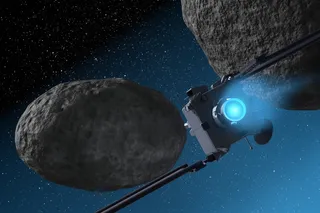Recently I went to Michigan to speak at a conference devoted totime reversal.
Time reversal? Yes, time reversal. Wow! you say. Reversing the flow of time?
Perhaps no other term in modern physics inspires as much fascination and awe in the general public. Consider the enormous popularity of such recent movies as Back to the Future I, II, and III, The Terminator, and Peggy Sue Got Married. But those people curious enough to trudge to a library and look up time reversal in an advanced physics text--for instance, chapter 4 in the classic by J. J. Sakurai, which I studied as a student--are bound to be disappointed. Physicists do not know how to arrange for you to go back to your high school days and see teen romance with the wisdom of an adult, as Kathleen Turner did. Nor can they send you or Michael J. Fox back in time to help your father beat out his competitor for the affection of your mother. Sorry to disappoint you, but we physicists haven’t the foggiest idea how to reverse the flow of time.
Physicists are focusing on a much more modest question, a question you have to ask before you can wonder whether or not you can go back in time. They are trying their damnedest to find out whether the fundamental laws of physics know about the arrow of time.
We are all aware of the psychological arrow of time, a subjective feeling that time flows mercilessly from the past to the future. Physicists also speak of a thermodynamic arrow of time along which physical systems invariably become ever more disordered. Perhaps the physiological arrow of time, measured by the aging of our bodies, is just a manifestation of this thermodynamic arrow of time. The expansion of the universe provides yet another arrow of time. The big question is whether, and how, these arrows are related to one another. In particular, we would all like to know how our psychological arrow of time comes about, and then, of course, whether we can reverse this arrow.
Well, dear reader, an incredible amount of quasi-philosophical speculation and mumbo jumbo has been uttered about these arrows of time, the kind of mumbo jumbo most physicists are just not smart enough to understand. In the time-honored tradition of their profession, physicists tend to want to answer one question at a time, starting hopefully with the simplest.
So let’s start with a simple one. Do the laws of physics contain in them an arrow of time?
Hold on, time out. What does this string of words actually mean? Physicists have the curious habit, when a question is posed to them, of demanding that the questioner outline a procedure--a series of operations, if you will--so that by following that procedure they can actually answer the question one way or another. I strongly recommend this attitude to the world at large. It is an operational approach guaranteed to save plenty of time and energy, not to mention hot air. Okay, you want to know how many angels can dance on the head of a pin. Just tell me a procedure whereby I can determine the answer, even if only in principle and not in actual practice. First, find some an-gels. . . . You get the point. Unfortunately for me, I got a terrible grade in the philosophy course I took in college because I kept pestering the professor: Give me an operational procedure to follow so I can determine whether what you just told me is true or not.
I will now give you the operational formulation of the question I mentioned above. Make a movie of a physical process. Run the movie backward. Are the events portrayed in the backward-running movie allowed by the laws of physics? In other words, can a bunch of physicists determine whether a movie is being played forward or backward? If not, then they say that the laws governing that process are invariant under time reversal: those laws don’t know beans about an arrow of time.
This is ludicrous, you say, now that I understand what you pinhead physicists are talking about. Of course the laws of physics are not invariant under time reversal. You invite a bunch of said pinhead physicists over to your place, pick out a videotape from your collection of vintage baseball clips, and stick it into your VCR. Ty Cobb ambles up to the plate, swings--yes!--the bat makes solid contact with the ball. Bam, wham. Home run! You press a button and the videotape reverses itself. A ball comes flying in from outside the stadium. It moves faster and faster-- whack!--it smacks the bat and Ty Cobb’s arm backward. Of course you can tell whether the movie is played forward or backward; you smirk in triumph.
Not so fast, the physicists reply as a chorus. Sure, it is improbable that a ball can come flying in from the parking lot and hit the bat, but it is not impossible. It is not forbidden by the laws of physics. A ball moving at just the right speed could push the bat backward.
But no, now it is your turn to object: When I play the videotape backward, the ball flies in faster and faster. Surely that is forbidden by the known laws of physics.
Yeah, yell the physicists, that’s because you forgot the motion of the air molecules. If your movie were sharp enough to show all relevant details, you would see that after Ty Cobb hits that ball, the ball keeps colliding with air molecules and thus slows down as it flies out of the park. When you play the movie backward, we would have seen--if your movie were sharp enough--zillions of air molecules conspiring to collide with the ball in precisely such a way as to push the ball faster and faster toward the bat. Perhaps just to fool us, you have somehow diabolically arranged for the air molecules to do precisely that.
The physicists, most of them being university professors, probably cannot resist giving you a didactic lecture about friction at this point. In the everyday world of macroscopic objects, we see friction working to slow things down, and this seemingly provides an arrow of time. But that, of course, is due to processes (such as collisions of the ball with air molecules in our example) that we have neglected to keep track of.
My somewhat silly story is meant to emphasize that to study time reversal, physicists simply examine one physical process after another and see whether the time-reversed process is allowed by the laws of physics. They early realized, obviously enough, that it is not necessary to look at such a complicated process as a home run. For the purpose of studying the time-reversal invariance of the laws of physics, it is enough to reduce complicated processes to ever simpler processes that, when put together, make up whichever complicated processes happen to interest us. And so from studying the collision between ball and bat, physicists move on to studying the collisions between molecules, between atoms, and between subnuclear particles.
For example, back in 1951, some physicists at the University of California at Berkeley crashed two protons together and observed a pion and a deuteron coming out of the collision. (For our purposes you don’t have to know what these particles are.) The time-reversed movie shows a pion and a deuteron colliding and producing two protons. So physicists at Columbia University and the University of Rochester did precisely that: they crashed a pion into a deuteron and observed two protons coming out. What they saw looked exactly like the movie of their California colleagues’ experiment played backward. The laws governing that particular process appeared to be perfectly time-reversal invariant.
Over the last few decades physicists have watched a lot of movies played forward and backward, and they have never seen hide or hair of an arrow of time anywhere in the fundamental laws of physics. Very strange, given that we see arrows of time all around us.
Of course, physicists are never so dumb as to say that they don’t see something. They say, We don’t see this or that at such and such degree of accuracy as limited by our apparatus, by how much money the people in Washington would give us, and so on. Over the years some extraordinarily persistent and hardworking experimenters have stretched their ingenuity to the limit to improve the accuracy to which they do not see an arrow of time in the laws of physics.
Physicists soon realized that crashing particles together was not the best way to study time reversal. In our example, the East Coast experimenters had to make sure that the pion and deuteron came together with precisely the same energy and momentum as they were observed to come out with on the West Coast. In the real world, you just can’t arrange that to a high degree of accuracy.
In 1956 physicists found a better way to go. To explain this, I have to ask you to remember how much fun it was to spin a top when you were a child. Every child knows that as a top spins, the axis around which it spins moves in a circle: it precesses. Let us film the spinning top. Now run the movie backward. We see the top precessing in the opposite direction, but the top is spinning in the opposite direction too. If you are an observant child, you notice that if you spin the top one way, it precesses one way, and if you spin the top the other way, it precesses the other way. In other words, you determine that the law governing the motion of the top is invariant under time reversal.
As a matter of fact, the electron also spins. Because there is no friction in the microscopic world, an electron just keeps on spinning at the same rate forever. The spinning electron acts like a little magnet, and in a magnetic field it precesses just like the spinning top precesses in Earth’s gravitational field. This precession of the electron in a magnetic field is observed routinely in the laboratory--no big deal. The direction in which the electron precesses depends on the direction of the magnetic field. If we reverse the magnetic field, the electron precesses the other way.
Does the precessing electron know about an arrow of time? Those physicists, they immediately made a movie and ran it backward--they are paid to do things like that. If you took physics in high school, you might remember that a magnetic field is produced only by moving electric charges. Charges that are sitting there produce not a magnetic field but only an electric field.
Okay, after this little bit of high school physics we can now turn on the projector, put in a movie of an electron precessing, and run it backward. The electron precesses the other way. We get excited! Can this be an arrow of time? By watching the direction in which the electron precesses, can we tell which way the movie is being played? But wait, the magnetic field also reverses direction, because the moving charges that produce the magnetic field move the other way in the backward-running movie. We can’t tell whether the movie is played forward or backward. No arrow of time anywhere in sight.
Flash! The light bulb goes on in your head. How about an electron precessing in an electric field? If you make a movie of that and play it backward, the electric field doesn’t reverse direction. Why? Because it is produced by charges just sitting there. But the electron precesses the other way. The forward-running movie and the backward-running movie look different: the electric field points in the same direction in both, but the electron precesses in different directions. You will find an arrow of time if you see an electron precessing in an electric field.
You rush to your lab, elbowing your colleagues out of the way. You set up an electric field and stick an electron in it. The instant you see it precessing, you can buy that ticket to Stockholm! Fame and glory for him or her who finds an arrow of time in the fundamental laws of physics!
I just gave you a rather long-winded explanation, with all that high school physics thrown in--I am a physics professor, after all. But I want to emphasize that the basic idea couldn’t be simpler. Under time reversal, magnetic fields reverse directions, but electric fields do not. If the laws of physics are invariant under time reversal, then the electron cannot possibly precess in an electric field as well as in a magnetic field.
A bit of terminology here: a particle that precesses in an electric field is said to have an electric dipole moment. So far I have focused on the electron, but nothing in the discussion depends specifically on the electron. If any particle possesses an electric dipole moment, then time reversal invariance is violated by the basic laws of physics. Experimenters have also worked to see if the neutron has an electric dipole moment. The search for the electric dipole moments of the electron and of the neutron has now been going on for almost 40 years, pursued by a group of persistent and, dare I say it, heroic experimenters who over the years have exercised their ingenuity to improve the accuracy of their measurements.
The story of the search for an electric dipole moment in nature illustrates well the difference between theoretical and experimental physics. It is all too easy for theorists to sit around and imagine an electron precessing in an electric field; it is entirely a different matter for experimenters to think of a way actually to observe this. When Gene Commins, the leader of an experimental group at Berkeley, came to the university where I work to give a lecture on time reversal, he drew an appreciative laugh from the audience when he remarked that what a theorist like Tony Zee thinks about for an afternoon will take me 20 years of hard work to prove or disprove.
For one thing, you can’t just stick an electron in an electric field; the electric force exerted by the field on the electron will push the electron out of the experimental apparatus in an instant. The experiment is actually performed on an atom. An atom is, of course, an electrically neutral collection of electrons and a nucleus. If the electron has an electric dipole moment, then the atom will also have an electric dipole moment. Over the years experimenters have had to overcome hordes of technical problems, not to mention problems caused by increasingly meager funding from Washington. (Commins and his friends can always dream of private funding. What if a tiny fraction of the profits from the movies on time reversal can be diverted to research on time reversal? Does anybody know Michael J. Fox’s phone number?)
After all this, I should tell you what the electric dipole moment is measured in--in centimeters, in grams, or what. Let us picture an electron as a tiny ball. Once again think of our childhood top, with that lopsided shape tapering to a point. The lopsided shape is necessary; otherwise the top won’t precess. No child has ever played with a perfectly round top. Thus the electric dipole moment of the electron, roughly speaking, is a measure of the extent to which the electron may not be perfectly round. Picture the electron as ever so slightly egg-shaped. Then the difference between the lengths of the long and short axes measures the lopsidedness. The electric dipole moment is measured in units of length.
Now I can give you an idea of how hard experimenters have worked over the years. Back in 1959 experimenters were able to say that the electric dipole moment of the electron is smaller than 10-15 centimeter. In some 30 years, the measurement has improved to 10-27 centimeter. In other words, if the electron is lopsided and not perfectly round, its lopsidedness is less than 0.000000000000000000000000001 centimeter, by far the smallest length ever measured by scientists. Personally, I am amazed by what experimenters can do.
Meanwhile, the theory of time reversal remains rather primitive. It is easy enough for theorists to include an arrow of time in various theories of the fundamental interactions. Several years ago, after I visited Norval Fortson, an experimental physicist at the University of Washington, I decided to cheer him up by concocting on the spot a theory in which the electron had a large electric dipole moment, big enough so Norval couldn’t help but see it soon. The poor guy had spent years and years looking for the electric dipole moment.
There are plenty of theories of time-reversal violation, but theorists often don’t even realize that some of those theories might contain large electric dipole moments. A couple of years ago the distinguished theorist Steve Weinberg told a gathering of physicists that according to a certain theory the neutron might have a rather large electric dipole moment. This came as a surprise and an embarrassment to the audience; the theory had been kicking around for some ten years, and all kinds of brilliant types had worked it over without seeing the possibility of a large electric dipole moment. Immediately after Weinberg’s talk, one of my colleagues, Steve Barr, and I realized that the electron would also have a large electric dipole moment, perhaps not much less than 10-27 centimeter.
The irony surely did not escape you: what the experimenters call an incredibly small length that will take them years to measure, the theorists refer to as large. Here you have one picture of the sociology of physics. A bunch of guys painstakingly spend their lives rummaging through the haystack looking for the proverbial needle. Some other guys are hanging around on the sideline, once in a while going through a cheerleading routine: Come on, guys, just look a little harder! Back comes the reply, We can’t find it! We’ve looked for more than 30 years! If it’s here, it’s got to be shorter than 10-27 centimeter. Hmm-- the guys on the sideline scratch their heads and then yell, Hey, according to this calculation here, it just might be a wee bit shorter than 10-27 centimeter. Don’t give up!
What makes time-reversal invariance even more mysterious is that since 1957 physicists have known that the laws of physics do not respect space reversal. As time reversal interchanges past and future, space reversal interchanges left and right. Indeed, every time we look in a mirror we have arranged for space reversal, known as parity to physicists. What you do is show a bunch of physicists a movie reflected in a mirror. In 1957 physicists figured out how to tell that they are seeing the movie in a mirror. So why can’t they tell if the movie is being played backward?
Another clue comes from mathematical reasoning. A mathematical theorem called the CPT theorem asserts that the laws of physics, in the way that physicists know how to formulate them, must be invariant under the combined operations of space reversal, time reversal, and something called charge conjugation (which I won’t go into here). For example, if we formulate a law that respects charge conjugation but violates space reversal, then it must violate time reversal. In 1964 experimental physicists found that the disintegration of a subnuclear particle called the kaon violates space reversal and charge conjugation in such a way that, according to the mathematical theorem, the disintegration must also violate time reversal.
For more than a quarter of a century, then, physicists have had indirect evidence that the laws of physics indeed violate time-reversal invariance. What physicists have been searching for in vain is direct evidence that time-reversal invariance is violated, without appealing to some fancy mathematical theorem. Physicists are a real skeptical lot and are never completely happy with mathematical theorems. Mathematical reasoning in itself cannot be wrong, but theorems have to start somewhere, with assumptions; and the assumptions that go into the proof of the CPT theorem, while seemingly reasonable to the vast majority of physicists, still make some physicists sit up at night and sweat.
To summarize the mystery, we know the butler committed similar misdeeds before: he did something to a mirror once. We suspect the butler, but we just can’t find the evidence that he did it. We even have an expert- -the guy who proved a mathematical theorem--swearing that the butler must have done it, but the judge won’t admit the expert’s testimony in court. And so those detectives just have to keep on combing the rug.
Finally, I should mention that time reversal is what physicists call a symmetry in the laws of physics. The symmetry between left and right, or symmetry by reflection in a mirror, is of course the most familiar, beloved by artists and architects. Time reversal is a symmetry between past and future. When I was writing my popular-physics book Fearful Symmetry, I kept putting off time reversal until the last chapter because I really didn’t, and still don’t, understand the nature of time. Neither does anybody else.
Early in this century Einstein told us that space and time are intimately related. Yet, as a conscious being, I know damn well that I am free to move left or right but just can’t move into the past when I please. If I didn’t know any better, I would have thought that the laws of physics, while perhaps symmetric between left and right, would not be symmetric between past and future. Experimenters have found precisely the opposite: the laws know about the difference between left and right, but not between past and future.
There, I’ve mentioned the words so dreaded by physical scientists, conscious being. Time is that one concept in physics we can’t talk about without dragging in, at some level, consciousness.
Well, when and if Gene Commins, Norval Fortson, and their friends see the electric dipole moment, will they be able to tell us how to build that time machine? you ask. Almost certainly not, at least not right away. The discovery of time-reversal violation in the fundamental laws may well represent a crucial step in the unraveling of the mystery of time. Eventually, who knows where it would lead? Logically, however, the discovery of time-reversal violation in the fundamental laws and the construction of a time machine are not necessarily connected in any way. Think of the case of space reversal. We can imagine a civilization on some planet without water, without mirrors. Conceivably, physicists in this civilization could eventually have discovered that the fundamental laws of physics are not invariant under space reversal, but they would still not know how to manufacture a mirror.
Sorry to disappoint you, but physicists still haven’t figured out the difference between past and future, and they certainly can’t send you on a ride with Michael J. Fox anytime soon. In fact, a physicist long ago pointed out a logical paradox against traveling backward in time known as the grandfather paradox. Indeed, all those popular movies about time travel basically play on that paradox. If Fox couldn’t punch out the bully and help his father get a date, where would he be? If Michael Biehn couldn’t save the mother of the rebel leader from the Terminator, what would have become of him? Well, you can always invoke the notion of parallel universes, with reality branching off at every instant into alternate realities, but that’s too wild for me. Hey, I’m a physicist, not a metaphysicist.
Go back to that little picture of how physics is done. Over there we see the haystack. Where are the people writing popular articles and books about physics? They are somewhere in left field, hawking popcorn to the masses. Like everything else, popular books on physics span the whole spectrum: the good, the bad, and the ugly. To keep on selling, some people feel they have to keep on hyping. I go to the bookstore and see books about parallel universes, the universe before the Big Bang, the universe before time, and I cringe. Let’s not forget the real heroes out there burrowing in the hay, ruining their eyes, and fighting the mice.
This article is an excerpt from Mysteries of Life and the Universe, to be published next month by Harcourt Brace Jovanovich. Proceeds from the book will benefit the National Commission to Prevent Infant Mortality.














